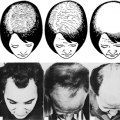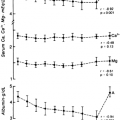INTRAOPERATIVE ASSESSMENT OF PARATHYROID PATHOLOGY
FAT STAINS
Because prominent, large fat droplets are found in the cytoplasm of normal chief cells and are absent in abnormal ones, the use of a sudan IV fat stain intraoperatively, at the time of frozen section, may conveniently and rapidly distinguish pathologic parathyroid tissue from normal tissue. In normal parathyroid glands, 80% of the cells are in a nonsecretory phase and contain cytoplasmic fat.10 The potential usefulness of the fat stain is illustrated as follows. A biopsy specimen of an enlarged parathyroid gland is sent for frozen section, and, by routine hematoxylin and eosin stain, is shown to be hypercellular with little or no stromal fat. Thus, it appears to represent an adenoma or hyperplastic gland. A biopsy specimen of the second parathyroid gland is normocellular or minimally hypercellular. The fat stain shows abundant cytoplasmic fat; hence, this second gland is normal. The enlarged gland, therefore, represents an adenoma. However, these clear-cut distinctions are not supported by some authors, who indicate that the use of the fat stain is helpful only in distinguishing normal from abnormal in ˜80% of cases. Complicating this issue is the fact that normal glands may show decreased fat.8,13,20 Thus, fat stains should serve as an adjunctive technique and should be considered in the light of gross findings, gland weight, and size.1,13,14,20,28
Stay updated, free articles. Join our Telegram channel

Full access? Get Clinical Tree





